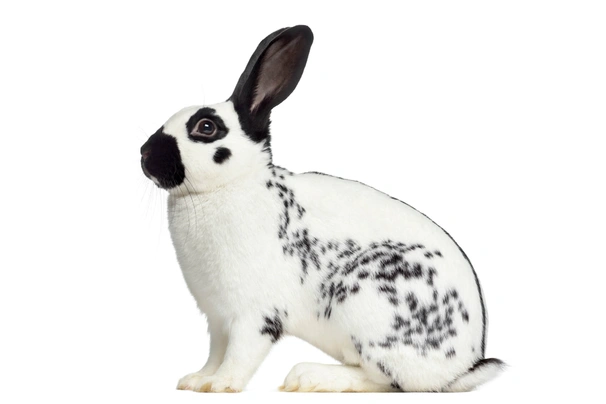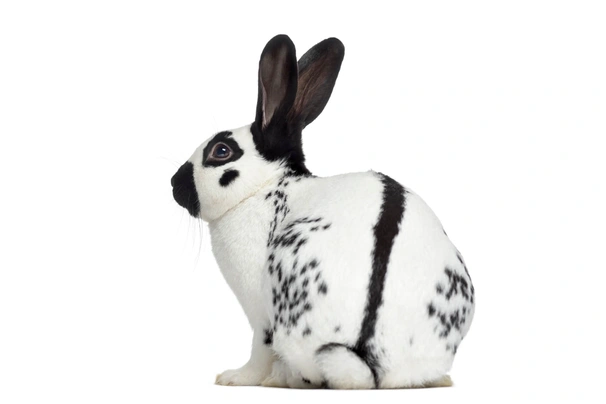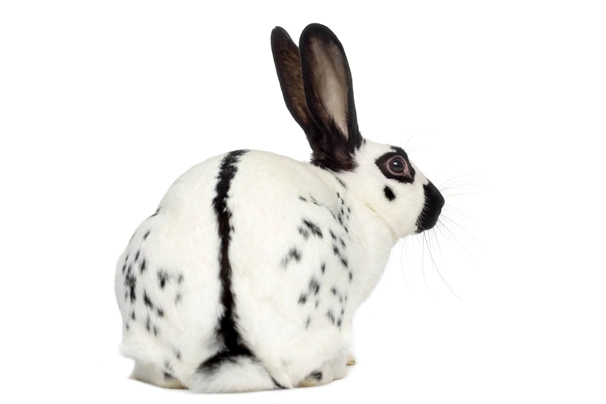English
Introduction of the English
The English is a fancy rabbit with a long history, having first appeared in the early 19th Century. This is a moderately sized rabbit that’s notable for its striking spotted and marked coat which includes a butterfly, circles around the eyes, coloured ears and cheek spots.
The English is accepted in seven different colourways, including black, chocolate and lilac as well as tortoise, blue and grey. The breed is known to be fun-loving and inquisitive and has a full, arched body and very long legs.
History of the English
Thought to be one of the most ancient breeds of fancy rabbit, the breed’s origins are shrouded in mystery, although it is believed to share a heritage with the English Butterfly and the Checkered Giant. These breeds share a number of features including cheek spots, herringbone and the coloured ears, although the Checkered is a much larger animal that usually weighs in at between 10-14lbs.
The first English Rabbits appeared in the early part of the 19th Century. By 1850 it had gained popularity and had made its way to the US by 1910. In 1924 the English Spot Rabbit Club was founded.
Appearance of the English
- Main colourways: white base colour with black, chocolate, blue, grey, lilac, tortoise and gold markings
- Average weight: 2.2 – 3.6kg
The English is a medium rabbit with a pronounced arch to the back and long, fine front legs that lift the body high so light is visible beneath the belly. Its hips are round and should be wider than the shoulder. This is not a compact, cuddly rabbit and its limbs and long and straight, the hind held parallel to the trunk. The ears must have colour and are held erect. Any English without the correct conformation will not display its markings to their best advantage.
Although it does resemble other breeds, the English is instantly recognizable thanks to its collection of distinctive markings. The rabbit should display a butterfly, a herringbone, cheek spots, coloured ears, a spray of dots and coloured circles around the eyes. When looking at English, the butterfly should ‘peak’ in the centre with a distinct ‘wing’ on either side. The markings on the cheeks are placed below the eyes, while a herringbone (simply a line of colour) stretches from the bottom of the animal’s ears down to the end of its tail, following the line of the spine. Every English Rabbit should also display a ‘chain’ of spots on each flank.
Temperament of the English
The English is well-known for being playful, friendly and intelligent. They are active and need access to space to run and play for a couple of hours every day. English Rabbits will be at their busiest during the morning and evening so this must be accommodated if you are planning on giving a home to an English.
This breed does make a good pet, but is perhaps better suited to a home with older children as it is a lively breed. It will enjoy lots of interaction and will appreciate lots of items to climb on, hide in and chew. Rabbits enjoy playing with household items such as cardboard boxes and tubes and a pretend ‘warren’ of lots of interconnecting boxes will provide hours of fun and a ramp placed against a sturdy box can make an excellent lookout.
All rabbits should be handled carefully as they can become fearful and stressed. If your rabbit panics while being held he could struggle and cause himself or his handler injury. Rabbits are more powerful than they look!
Health of the English
As a hybrid animal, the English is relatively hardy and healthy, there is however a number of issues that can affect all rabbits and for which any owner must remain vigilant.
Sore hocks are caused when an animal spends too long on a wire floor. The wires and uneven surface wear the protective fur away on the animal’s hock area and the exposed skin can easily break and crack. All rabbits should be housed in a hutch or shed with a solid floor – even if he’s housed indoors in a dog crate, the floor should be covered with a crate tray or piece of wood.
His teeth should be monitored closely as they grow continually and can get too long. Any overgrown molars or enamel spurs can cause injuries to the soft mouth tissues and can make eating difficult. Any overgrown teeth must be trimmed by a vet.
The diet of your rabbit should also be carefully planned as an overweight bunny can be prone to a few conditions, not least the distressing flystrike. Flystrike occurs when an overweight or otherwise incapacitated rabbit, fails to groom itself and develops soiled fur. In warmer weather, and particularly if the animal is housed outside, flies can be attracted to the soiled areas and lay their eggs in the fur, leaving the hatching larvae to burrow under the skin, causing open wounds and great discomfort.
It’s worth getting non-breeding does spayed, as this helps prevent uterine cancer, which is common in rabbits and all animals should be treated regularly worms, fleas and ticks. They should also be vaccinated against myxomatosis and Viral Haemorrhagic Disease.
Caring for the English
Before you bring your rabbit home you should decide where he’s going to live – indoors or outdoors. If he’s going to live outdoors he should be given a large weather and waterproof hutch that’s roomy enough for him to hop and stand on his hind legs. It should have a separate sleeping area and a fine mesh front. It should be lined with hardwood shavings and straw and cleaned out properly once a week, with droppings removed daily. An outdoor hutch must be placed out of direct wind and sun – a well-ventilated, well-lit shed is ideal. He should also be given access to an outdoor space too, so he can run and explore.
If he’s going to be a house rabbit he should be provided with a safe area he can sleep and relax in. A lined dog crate is perfect for this. He should also be trained to use a litter tray and all cables, wires, shoes and other important items must be kept out of his way. Again, he will also need regular access to the outdoors to satisfy his natural instinct to play and graze.
His diet should comprise good quality hay, good rabbit pellets and fibrous green vegetables and leaves such as kale, cabbage, dandelions and clover. A diet like this, that’s high in roughage, will also help wear down his teeth and prevent them from overgrowing. Clean, fresh drinking water should be available at all times.


